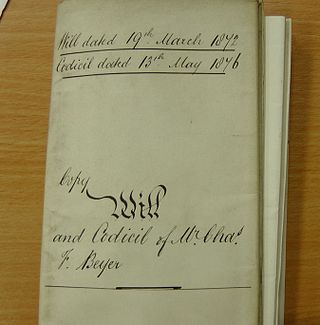At common law, damages are a remedy in the form of a monetary award to be paid to a claimant as compensation for loss or injury. To warrant the award, the claimant must show that a breach of duty has caused foreseeable loss. To be recognised at law, the loss must involve damage to property, or mental or physical injury; pure economic loss is rarely recognised for the award of damages.

In common law jurisdictions, a misrepresentation is a false or misleading statement of fact made during negotiations by one party to another, the statement then inducing that other party to enter into a contract. The misled party may normally rescind the contract, and sometimes may be awarded damages as well.

The Supreme Court of the United States handed down sixteen per curiam opinions during its 2005 term, which lasted from October 3, 2005, until October 1, 2006.
United States v. Interstate Commerce Commission, 337 U.S. 426 (1949), is a decision of the Supreme Court of the United States addressing several issues, including the judicial standard of one party's inability to sue itself, the ability of the United States government specifically to sue federally affiliated departments, and the ability of courts to determine legislative intent. While this decision did not have many broad implications, it did offer a more "common-sense" understanding of determining what constitutes a justiciable controversy.
Pullman Palace Car Co. v. Speck, 113 U.S. 84 (1885), was an appeals case from the circuit court for the Northern district of Illinois a case that had been removed from that court. The appeal was on the grounds that while a party who has a case for removal is not put to his election to exercise or abandon the right to remove at the moment of entering his appearance, he is not permitted unreasonably to delay this election during all the period incident to the preparation of the case, until both parties find themselves in condition to go to trial at law.
Griffith v. Godey, 113 U.S. 89 (1885), was a suit regarding equity of defendants who were trustees of certain property that the complainant was interested in, and which they received and disposed of. The complainant, Ellis Griffith, and his brother, John Griffith, were partners, engaged in the business of cattle raising, and resided in Kern County, California, where they occupied what is called a stock range, a tract of country on which cattle are permitted to roam and graze. It may be termed the feeding ground-the pasture land of the cattle. Although the title to the land constituting the range was in the United States, and the land was not inclosed, the right of the Griffiths to use it for the pasturage of their cattle was recognized and respected by their neighbors and other stock raisers in the county. It had excellent springs, furnishing water to cattle roaming over a large extent of country, and was capable of supporting from one to three thousand head. The property, therefore was of great value.
Central Railroad & Banking Co. of Ga. v. Pettus, 113 U.S. 116 (1885), was an appeal from a decree of the Circuit Court of the United States for the Middle district of Alabama in favor of the appellees, Pettus & Dawson and Watts & Sons, adjudging them entitled to the sum of, 161.21, and interest thereon at eight percent per annum from March 7, 1881, with lien, to secure its payment, upon the roadbed, depots, side tracks, turnouts, trestles, and bridges owned and used by the appellants, corporations of the State of Georgia, in operating the railroad formerly belonging to the Montgomery and West Point Railroad Company, an Alabama corporation, and which extends from Montgomery to West Point with a branch from Opelika to Columbus. This property was directed to be exposed to sale unless within a given time the said amount was paid. This suit is the outgrowth of certain litigation in the courts of Alabama relating to the before-mentioned and other railroad property in which the appellants are interested.

Clawson v. United States, 113 U.S. 143 (1885), was a case regarding a Utah territorial statute which authorized an appeal by a defendant in a criminal action from a final judgment of conviction, which provides that an appeal shall stay execution upon filing with the clerk a certificate of a judge that in his opinion there is probable cause for the appeal, and further provides that after conviction, a defendant who has appealed may be admitted to bail as of right when the judgment is for the payment of a fine only, and as matter of discretion in other cases, does not confer upon a defendant convicted and sentenced to pay a fine and be imprisoned the right, after appeal and filing of certificate of probable cause, to be admitted to bail except within the discretion of the court.
Harvey v. United States, 113 U.S. 243 (1885), was a case for labor and materials furnished by the claimants in constructing coffer dams in Davenport, Iowa and in performing the work necessarily connected therewith and preliminary to the mason work for the piers and abutments referred to in the contract. That court proceeded on the view that the claimants had no right to rely on the testimony of experts introduced by them as to the value of the work, but should have kept and produced accounts of its cost and expense, but it gave to the claimants the benefit of the testimony of experts introduced by the United States as to such value in awarding the above amount. Held that the claimants could not be deprived of reasonable compensation for their work because they did not produce evidence of the character referred to, when it did not appear that such evidence existed, if the evidence they produced was the best evidence accessible to them and it enabled the court to arrive at a proper conclusion.
Coon v. Wilson, 113 U.S. 268 (1885), was a suit filed in the United States Supreme Court regarding the infringement of reissued letters patent No. 8, 169, granted to the plaintiff, Washington Wilson, as inventor, April 9, 1878, on an application therefor filed March 11, 1878, for an "improvement in collars," the original patent, No. 197,807, having been granted to him December 4, 1877.
Spaids v. Cooley, 113 U.S. 278 (1885), was regarding a lawsuit brought to the Supreme Court of the District of Columbia in the United States on December 13, 1876, by Chauncey D. Spaids against Dennis N. Cooley to recover $593.70, with interest from July 1, 1868.
Sully v. Drennan, 113 U.S. 287 (1885), was an appeal from an order of the Circuit Court for the Southern District of Iowa in the United States remanding to the state court a case which had been removed from the state into the circuit court.
Chicago & Northwestern R. Co. v. Crane, 113 U.S. 424 (1885), was a suit brought by a taxpayer and resident in the Town of Polk City, Iowa, on behalf of himself and all other resident voters, taxpayers and property holders, commenced suit in a state court of Iowa against two companies, praying for a peremptory writ of mandamus to compel the reconstruction and operation of the old line after the Chicago and North Western Railway, an Illinois corporation. changed the line and made it avoid the city, constructing a branch to the latter. C&NW Railway was leased the line by the D&M Railroad Company, an Iowa Corporation, who had received from a township in Iowa, in consideration of its agreement to construct and maintain a railroad to a city in the township, the proceeds of a special tax and a conveyance of a large amount of swamp lands. It constructed the railroad and operating it for a time before leasing it to C&N Railway.
Union Pacific Railway Co. v. Cheyenne, 113 U.S. 516 (1885), was an appeal from the Supreme Court of the Territory of Wyoming regarding a bill charging that the collection of an illegal tax would involve the plaintiff in a multiplicity of suits as to the title of lots being laid out and sold, which would prevent their sale, and which would cloud the title to all his real estate, states a case for relief in equity.
The English law of unjust enrichment is part of the English law of obligations, along with the law of contract, tort, and trusts. The law of unjust enrichment deals with circumstances in which one person is required to make restitution of a benefit acquired at the expense of another in circumstances which are unjust.
Tolling is a legal doctrine that allows for the pausing or delaying of the running of the period of time set forth by a statute of limitations, such that a lawsuit may potentially be filed even after the statute of limitations has run. Although grounds for tolling the statute of limitations vary by jurisdiction, common grounds include:
Cooper Manufacturing Co. v. Ferguson, 113 U.S. 727 (1885), was a suit regarding the legitimacy of a sale of a steam engine and other machinery in the State of Ohio.
Gregory v. Hartley, 113 U.S. 742 (1885), was a case in error to the Supreme Court of the State of Nebraska where it was decided and reaffirmed that the words "term at which said cause could be first tried and before the trial thereof," Act of March 3, 1875, c. 137, § 3, 18 Stat. 471, mean the first term at which the cause is in law triable, i.e., in which it would stand for trial if the parties had taken the usual steps as to pleadings and other preparations. Babbitt v. Clark, 103 U.S. 808, and Pullman Palace Car Co. v. Speck, ante, 113 U.S. 87.
Looney v. District of Columbia, 113 U.S. 258 (1885), was a U.S. Supreme Court case testing whether a government contractor could sue for outstanding payment when those debts had already been sold off to other parties. The court ruled a street contractor could not both sell the debts at a discount as a security and also sue District of Columbia for the difference in what they were owed.

Dillwyn v Llewelyn [1862] is an 'English' land, probate and contract law case which established an example of proprietary estoppel at the testator's wish overturning his last Will and Testament; the case concerned land in Wales demonstrating the united jurisdiction of England and Wales.




